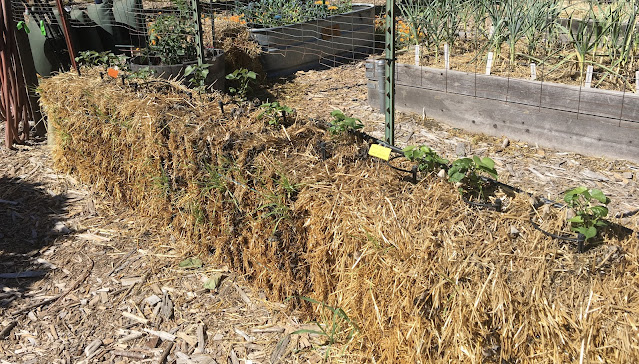
Sessions focus on straw-bale gardening, vegetable growing

|
|
Here's one example of a straw-bale garden, at the Fair Oaks Horticulture Center
in May 2018. Sweet potatoes were planted in the bales that year. (Photo: Kathy
Morrison)
|
Any gardener who'd just as soon not risk a crowd, even outdoors, right now should be happy to know that the region's master gardeners have your back.
Two free Zoom online workshops are scheduled for Saturday, Jan. 22:
-- 9 a.m. to noon. "Spring and Summer Vegetables" is the topic covered by the El Dorado master gardeners. Master gardener Zack Dowell will discuss garden plant selection, planting times, site selection, soil preparation, proper seed planting techniques, and pest management.
Registration is free but required here: https://surveys.ucanr.edu/survey.cfm?surveynumber=36315
Visit the El Dorado master gardeners' website https://mgeldorado.ucanr.edu/ to see what else they have planned for workshops through March.
-- 10:30-11:30 a.m. "Straw-Bale Gardening" is offered by the Placer County master gardeners. Straw-bale gardening in easily conditioned straw bales, they note, offers "no soil, no digging, no bending, only a trowel needed." The workshop will show how to set up and condition the bales, which can be used for all types of vegetables, from tomatoes to sweet potatoes, as well as herbs or flowers.
The Zoom Link: https://us02web.zoom.us/j/83410416355?
Passcode: garden
The Placer master gardeners' main website is https://pcmg.ucanr.org/ where the calendar of all their late-winter Zoom workshops is available.
-- Kathy Morrison
Comments
0 comments have been posted.Sacramento Digs Gardening to your inbox.
Sites We Like
Garden Checklist for week of July 21
Your garden needs you!
* Keep your vegetable garden watered, mulched and weeded. Water before 8 a.m. to reduce the chance of fungal infection and to conserve moisture.
* Feed vegetable plants bone meal, rock phosphate or other fertilizers high in phosphate to stimulate more blooms and fruiting. (But wait until daily high temperatures drop out of the 100s.)
* Don’t let tomatoes wilt or dry out completely. Give tomatoes a deep watering two to three times a week.
* Harvest vegetables promptly to encourage plants to produce more. Squash especially tends to grow rapidly in hot weather. Keep an eye on zucchini.
* Pinch back chrysanthemums for bushy plants and more flowers in September.
* Remove spent flowers from roses, daylilies and other bloomers as they finish flowering.
* Pinch off blooms from basil so the plant will grow more leaves.
* Cut back lavender after flowering to promote a second bloom.
* It's not too late to add a splash of color. Plant petunias, snapdragons, zinnias and marigolds.
* From seed, plant corn, pumpkins, radishes, winter squash and sunflowers.